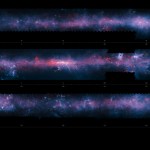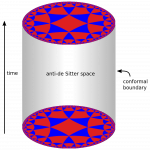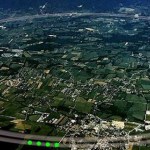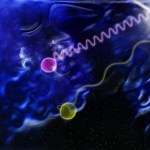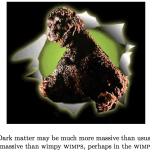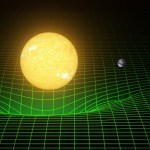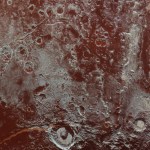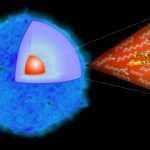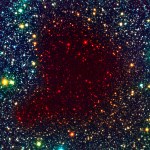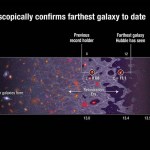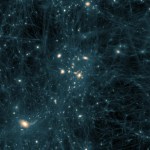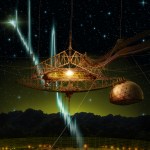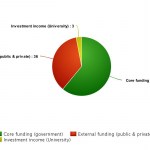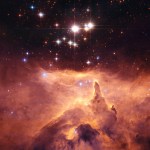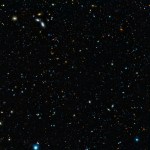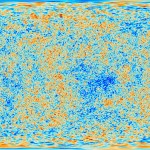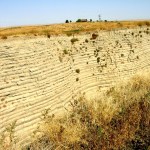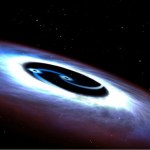
"True realism consists in revealing the surprising things which habit keeps covered and prevents us from seeing." -Jean Cocteau
Each time you look at a photograph of the Universe, you aren't just seeing it as it was at a particular moment in time, but also in a particular wavelength (or set of wavelengths) of light! Different wavelengths can reveal different phenomena and components of the Universe, from dust and gas to starlight, plasma, black holes and beyond.
The view of the galactic center in four different wavelength bands. Atop, from the ATLASGAL survey at 870 microns; below that…
“[W]hen I was younger, I was afraid of something that didn't make a lot of sense. But now I'm not. I have nothing to worry about. It doesn't matter.” -Maurice Sendak
Well, here in the USA we're all still reeling from the loss of an hour for daylight savings time, and in the meantime, I've been reeling here at Starts With A Bang as I sift through your comments. Maybe there was something special about this week, but you weighed in with hundreds of comments on the following:
Is this a hole in the Universe? (for Ask Ethan),
Pluto's color variations finally make…
"It is in the theory of perception that we have established our bond, or the lie I should say, for which we kill. We are nothing without our image. Without our projection. Without the spiritual hologram of who we perceive ourselves to be or rather to become, in the future. When you are lonely, I will be lonely too. And this is the fame." -Lady Gaga
One of the more remarkable discoveries in human technology is the hologram. Instead of mapping a snapshot of our three-dimensional world from a single perspective onto a two-dimensional surface, we can create a light map of the entire three-…
John Oliver: So, roughly speaking, what are the chances that the world is going to be destroyed? One-in-a-million? One-in-a-billion?
Walter Wagner: Well, the best we can say right now is a one-in-two chance.
John: 50-50?
Walter: Yeah, 50-50… It’s a chance, it’s a 50-50 chance.
John: You come back to this 50-50 thing, what is it Walter?
Walter: Well, if you have something that can happen and something that won’t necessarily happen, it’s going to either happen or it’s gonna not happen. And, so, it’s kind of… best guess at this point.
John: I’m… not sure that’s how probability works, Walter. –…
"If you are not completely confused by quantum mechanics, you do not understand it." -John Wheeler
Now that LIGO has detected gravitational waves directly, it's time to examine all the different sources that they come from, and what they can teach us about the Universe. While accelerating masses in strong gravitational fields -- black holes, neutron stars and the like -- will produce gravitational waves capable of being seen by direct detection experiments, there's another class of gravitational waves that's observable through its effects on the leftover light from the Big Bang: gravitational…
"Eight solid light-years of lead...is the thickness of that metal in which you would need to encase yourself if you wanted to keep from being touched by neutrinos." -Michael Chabon
When it comes to dark matter, the most commonly considered candidates are WIMPs, or Weakly-Interacting Massive Particles. But with the failure of the LHC to turn up anything compelling at the ~100 GeV scale, or any robust hints of a new particle, for that matter, it might be time to consider another possible solution at much higher energies: a heavy, right-handed neutrino.
Image credit: public domain…
"The fundamental choice is not whether humans will have faith, but rather what the objects of their faith will be, and how far and into what dimensions this faith will extend." -Matt Emerson
Writing in the Wall Street Journal, Matt Emerson asserts that science is faith-based, since scientists believe that the predictions of their theories will be borne out. It's true that faith, by definition, is the belief in an outcome for which we cannot be certain. Indeed, we could not have been certain that LIGO would have found gravitational waves, nor that Einstein's predictions for their properties…
"This is in a real sense the capstone of the initial missions to explore the planets. Pluto, its moons and this part of the solar system are such mysteries that New Horizons will rewrite all of the textbooks." -Alan Stern
The New Horizons mission surprised everyone last July when it revealed Pluto to be a world that varied significantly in both terrain and color. Instead of a uniform, reddish-hued icy world, it was revealed to have mountains, craters, smooth plains, pitted regions and more, which range in color from white to yellow to deep red.
Image credit: NASA/JHUAPL/SwRI, of the…
“Mistakes can be corrected by those who pay attention to facts but dogmatism will not be corrected by those who are wedded to a vision.” -Thomas Sowell
It's hard to believe, but it's already almost time for spring! After leaping an extra day to help keep our calendar in synch, March started off with an amazing string of stories over at Starts With A Bang, including:
Why are maps of the cosmos oval-shaped? (for Ask Ethan),
A new hope for our galaxy's next supernova (for Mostly Mute Monday),
Why college is so expensive, and how to fix it,
The mystery of fast radio bursts deepens…
“Youth always tries to fill the void, an old man learns to live with it.” -Mark Z. Danielewski
There are plenty of scientific myths that go around, including many that were generated recently by so-called science communicators that actively harm public knowledge. One of them was a now-famous image of a dark nebula silhouetted against a star field, claiming that this was a hole in the Universe a billion light years across with no matter in it.
Image credit: ESO, of the same object in a composite of visible, near-IR and farther-IR light.
Not only is the image itself a completely…
“Whenever I gaze up at the moon, I feel like I’m on a time machine. I am back to that precious pinpoint of time, standing on the foreboding — yet beautiful — Sea of Tranquility. I could see our shining blue planet Earth poised in the darkness of space.” -Buzz Aldrin
Seen from afar, Earth is often described as a pale blue dot. But why is our planet blue? Is it because the skies are blue? That can't be right, or the clouds and icecaps would appear blue-hued as well. Is it because the blue skies are reflected by the oceans? That can't be right either, or we wouldn't see different shades of blue…
"Our spectroscopic observations reveal the galaxy to be even farther away than we had originally thought, right at the distance limit of what Hubble can observe." -Gabriel Bremmer
One of the holy grails of cosmology is to measure, directly, exactly when the first stars and galaxies formed in our Universe. The Hubble Space Telescope has been pushing the distance record farther and farther back, with its measurements typically confirmed by ground-based, spectroscopic follow-ups. This time, however, the new record-holder was so distant that confirmation needed to be done from space: by Hubble…
"If you take everything we know... it only adds up to 5% of the Universe." -Katie Freese
One of the greatest advances of the 20th century was the discovery of the vast nature of the cosmos: that it was filled with billions of galaxies, each containing billions of stars, and that it extended in all directions for at least tens of billions of light years. Yet when we look out at the full gamut of all there is, the stuff that's normal matter -- made of the same protons, neutrons and electrons that we are -- can account for no more than 5% of the total energy in the Universe.
Image credit: NASA…
"From a little spark may burst a flame." -Dante Alighieri
Last week, it was reported that the mystery of fast radio bursts were solved, and that they were due to the merger of a neutron star with another collapsed object, well outside of our galaxy. However, not only was that analysis fundamentally flawed, but a new paper out today identifies fast radio bursts that repeat, a dealbreaker for the merger scenario.
Image credit: Alex Cherney, of the Australia Telescope Compact Array, where the follow-up observations were performed.
Instead, it's thought that these events come from the…
"When we make college more affordable, we make the American dream more achievable." -Bill Clinton
Over the next four years, the University of Helsinki will see its budget reduced by approximately 100 million Euros, or about 15% of its annual expenditures. As a response, it's reducing its workforce by 980 members, a necessary cut given the budgetary changes.
Image credit: E. Siegel, created at https://www.meta-chart.com/pie, with data from University of Helsinki here: https://www.helsinki.fi/en/university/strategy-and-management/universit….
Yet how they chose to cut their budget…
"Some of them burn slow and long, like red dwarfs. Others -- blue giants -- burn their due so fast they shine across great distances, and are easy to see. As they start to run out of fuel, they burn helium, grow even hotter, and explode in a supernova. Supernovas, they're brighter than the brightest galaxies. They die, but everyone watches them go." -Jodi Picoult
One of the toughest things to predict is where our galaxy's next supernova will occur. The smart bet is that it will be a massive star, 20 times the Sun's mass or more, as more than 80% of the Universe's supernovae are of…
“A great accomplishment shouldn't be the end of the road, just the starting point for the next leap forward.” -Harvey Mackay
Tomorrow is such a big, rare day that it only comes once every four years (or 4.1237 years, for a little greater precision), yet practically every day offers something new and wonderful here at Starts With A Bang. If you missed anything over the past week, here's what we've taken a peek at:
Do gravitational waves exhibit wave-particle duality? (for Ask Ethan),
Astronomers push the limits of Hubble (for Mostly Mute Monday),
Sorry, but…
"The bedrock nature of space and time and the unification of cosmos and quantum are surely among science's great 'open frontiers.' These are parts of the intellectual map where we're still groping for the truth - where, in the fashion of ancient cartographers, we must still inscribe 'here be dragons.'" -Martin Rees
We know the Earth is an almost-perfect sphere, yet maps of it always stretch it down to a two-dimensional surface. Outer space, too, when we look at it, offers views that extend deep into the cosmos in all directions, also on a sphere. But if you want to make a map of the Universe…
"Will you or won't you? Should you or shouldn't you?
Use this day to do something daring, extraordinary and unlike yourself." -Vera Nazarian
The need for a February 29th, once every four years or so, doesn't just give us an extra day this year, but it keeps the calendar from drifting and failing to align with the seasons. Even so, the scheme we have worked out today -- where years divisible by 4 but not those divisible by 100 unless also divisible by 400 get an extra day -- isn't perfect, and will get worse as time goes on.
Image credit: flickr user Kevin Gill, under c.c.a.-s.a.-2.0. A quick…
"Even if the Fermi detection is a false alarm, future LIGO events should be monitored for accompanying light irrespective of whether they originate from black hole mergers. Nature can always surprise us." -Avi Loeb
Ever since LIGO first announced the direct detection of gravitational waves from two merging black holes, the physics and astronomy community has been struggling to understand an unexpected phenomenon that appears to have come along with it: a short-period gamma ray burst.
An artist’s impression of two stars orbiting each other and progressing (from left to right) to merger with…
